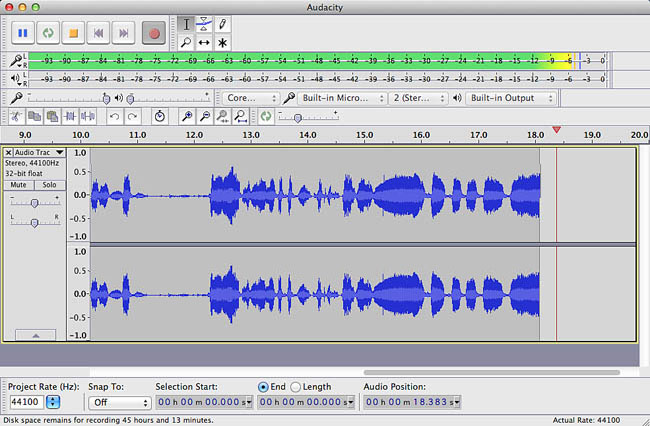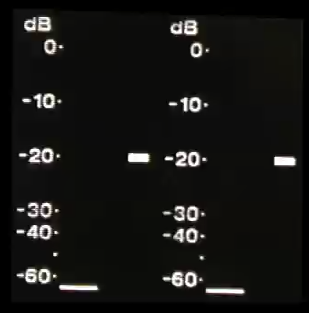I am looking at finding my 0dB reference on a mixer and want to generate some pink noise at 0dB
Would the default amplitude of 0.8 generate the 0dB pink noise?
Do you want 0 dB peak amplitude?
Because “noise” is random, the peak value is not really a reliable measure. More usually RMS level is used for this type of thing, but a lot lower than 0 dB.
The default 0.8 will generate a peak level of “about” +/- 0.8 linear (not exact, because of the random nature).
0.8 linear is -1.9382 dB relative to full scale.
Generating to 1.0 will give a peak level of about +/- 1.0 linear (0 dB).
To get a specific RMS level, generate some noise (default 0.8 will do), then use this plug-in to amplify to the required RMS level. https://forum.audacityteam.org/t/rms-normalize/40902/1 Read the full post for details about the effect and installation instructions.
It would be better to generate a constant tone.
You can’t generate pink noise at 0. Noise is a rumply fuzz ball not one constant thing. Some of it goes over the specified value. You can’t go over 0 (outside of Audacity), so that’s the end.
We’ve been using tone for decades. A-440 is a favorite. That’s the oboe tone at the beginning of the orchestra. 440Hz at whatever your reference level is. Zero isn’t good because that can trigger overload sensors and create damage at some standards conversions (like MP3). All you need is for everybody to know what the level is, whichever you pick. If it’s critical, you can build your voice into the tone.
Boooooooooo “Minus 6” Boooooooooo.
We used to use 1000Hz tone, but that was a little too piercing and it tended to tangle with FM Radio transmitter audio processing.
440Hz it is.
Koz
Basically i use a mixer/controller and although my VU meters have 0Db, +6dB etc i want something like white noise or pink noise so that i can see if the values on the controller are true. So if i play an mp3 or Wav file known to be 0dB it will help set my reference point
my VU meters have 0Db, +6dB etc
Analog VU Meters. You can do that, but you have to decide where zero is. Zero calibrate point on the analog VU meters translates to something lower than zero in digital. Common digital doesn’t go over 0. In digital, 0 is the smash, crash, overload point.
Let’s see. Digital television zero VU is -18 digital. Home DV camcorder reference tends to settle at -12 digital. There used to be an Audio CD reference standard of -17 digital…I think. That hasn’t been used in years which makes mixing an older CD with a newer one a real challenge.
Ballistics will make you nuts, too. Analog VU meters are designed to ignore peaks and rapid changes in volume. They respond roughly to loudness in the show. That’s very very different from digital meters. They’re peak-reading and respond instantly to everything.
It’s good to standardize on one measurement system rather than slosh back and forth between them.
When I record my analog sound mixer. I set it up correctly, connect it to Audacity for recording and then back down the mixer levels until I get good Audacity recording meters. I’ve done broadcast radio like that.

Koz
Here. I thought I had this around. This is an illustration of an analog video machine and later digital one. Note the digital one stops at 0 on top and has a marker at -20. That’s the approximate broadcast translation point for 0 VU.
Koz


Ok i will give more detail as i have been a bit vague.
My application is portable sound, i.e Mobile DJ work.
I use one of these http://denondj.com/products/view/dn-mc6000#.VpIkgxWLSUk in conjunction with Virtual DJ software.
Now the software i have set so my signal out to my mixer/controller is is limited to -3dB so that the digital signal never hits 0dB its maximum.
What i want to do is see on that controller by playing some noise white/pink a 0dB reference, as currently with all settings at unity i,m hitting +8dB ( if it really is +8dB)
There are also two “standards” for 0 dB input level.
In professional audio, equipment may be calibrated to indicate a “0” on the VU meters some finite time after a signal has been applied at an amplitude of +4 dBu. Consumer equipment typically uses a lower “nominal” signal level of -10 dBV.
OK, thanks,
this kind of describes it to me
When using a VU meter the audio system is calibrated with a sine wave tone at a “reference level” for the system. At the reference level the VU meter will show “0” for a sine wave tone, but the engineer must know that with music or speech the Peak levels will always be “inferred” to be between 6dB to 10dB higher than the reference level. The genius of the VU meter is that for most types of audio sources the system engineer can count on these peaks being within this range and can design the audio system with confidence. Good engineering practice is to always build in a little extra “headroom” as it is called, to cover the strange conditions where an audio signal might exceed normal peak levels or the equipment operator fails to adjust the levels correctly. Typically the levels to be considered when designing systems using a VU meter are:
Reference Level (typically +4dBu, valid with tones only)
Standard Output Level (10dB above Reference, typical peak levels)
Clip Level (6dB above Standard Output Level, “headroom” to allow for unusual conditions)